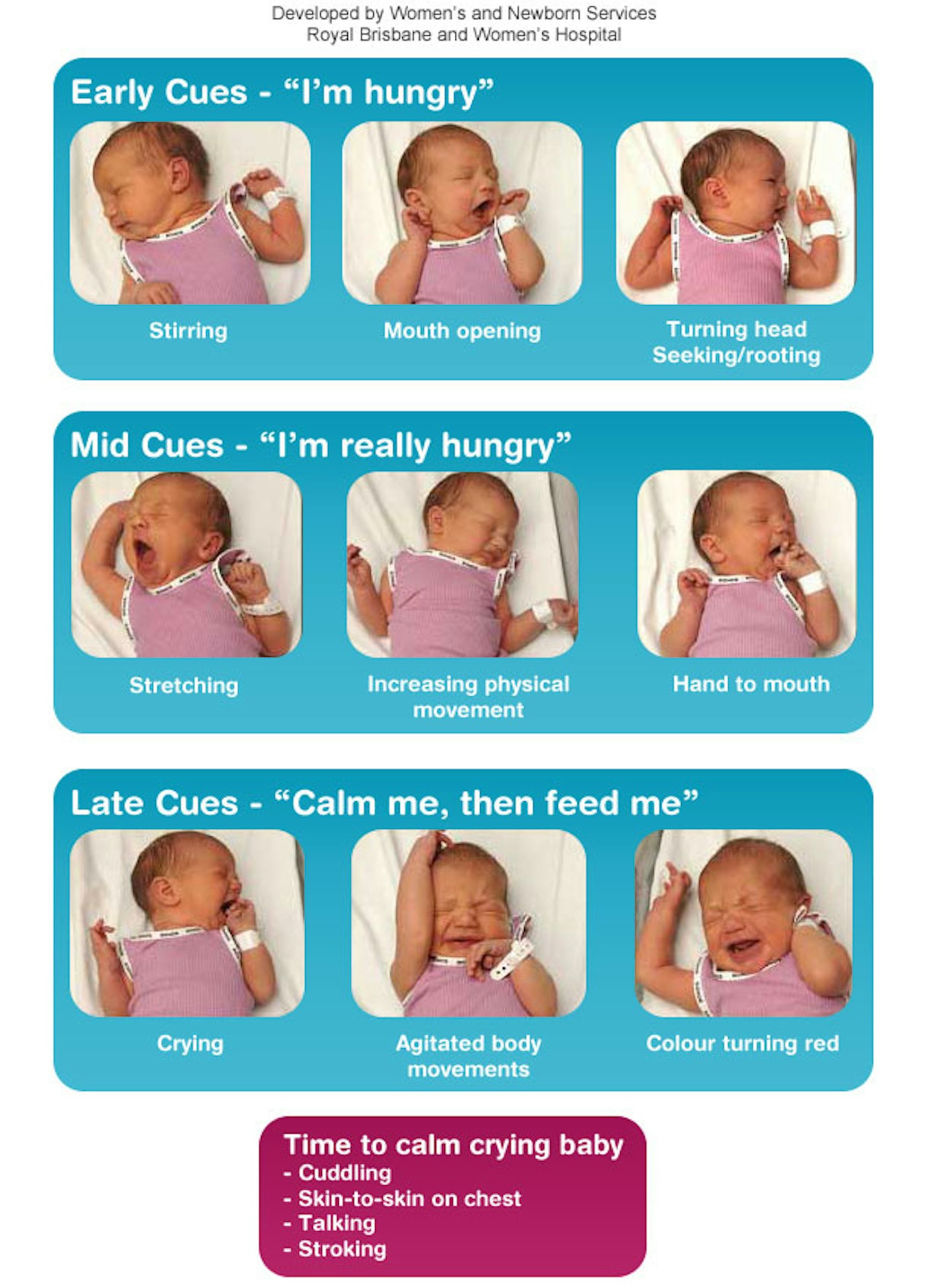Section: Feeding
Breastfeeding your newborn can be a wonderfully fulfilling, bonding experience and is the start of your incredible journey getting to know your baby.
Yet with everything so new, things might not always run smoothly – especially given the surprising impact your labour can have on feeding. Luckily help is at hand!
Geraldine Miskin, an independent breastfeeding specialist, gives Mother&Baby her expert advice and her easy guide to newborn breastfeeding.
"The first two weeks of breastfeeding require a great deal of patience and open-mindedness as it is such a unique time in the breastfeeding," says Geraldine.
"It’s a steep learning curve as both mum and baby are learning an entirely new skill. It feels like it should instantly come naturally but often takes a little time and practice for many babies. Feeding frequency and feeding patterns vary considerably, which is why I encourage new mums to focus on the practical and physical elements of feeding," she says.
Breastfeeding tips for new mothers
-
Anticipate your baby's needs: Rather than waiting for your baby to cry, try and look for other signs that they're hungry, like raising their head a lot or opening and closing their mouth.

-
Let your baby set the schedule: Your little one knows how much they need, so let them determine how long they feed for and don't set a prescribed time between feeds. Remember breastfeeding works by supply and demand, the more you feed the baby or pump the more milk will be produced and the less milk you remove from the breast, the less you will produce.
-
Feed in a comfortable position: If you're constantly squirming and moving to get comfy this can affect your baby's feed. Find a comfortable sofa or bed to feed on with plenty of back support.
-
Relax: Your baby can tell if you're tense and nervous about feeding and they might not latch properly, take some deep breaths before you start or maybe invision a 'happy place'. La Leche League encourages taking time to relax and find a good position, "especially if you are breastfeeding more than one baby or if your baby is fussy or unwell."
-
Reduce stress: As in pregnancy, it is important that you try to remain as calm as you can throughout your day. Stress produces a hormone called cortisol which reduces lactogenesis (the ability to secrete milk) and can have a negative impact on your milk supply and let down.
-
Help your baby find the right position: Pay attention to the position that works best for them, and try to help them get there quickly without forcing them. Ensure that you are supporting your baby’s head, neck and back adequately, but be sure not to restrict them. Your baby should have the ability to move their head back at all times to avoid risk of suffocation or choking. Using a nursing pillow may help with this. If you don't have a nursing pillow, your old pregnancy pillow can also work.
-
You'll need breast pads: If you hear another baby cry, go a few hours without feeding or even feel strong emotions, your milk might leak, so it's worth popping a breast pad in your bra to soak this up.
-
Take care of your skin: Your delicate breast skin can get dry and chapped when you're breastfeeding, so make sure to apply healing products and wear loose comfortable clothing. Your breastmilk can also be used to moisturise your breasts. Since your milk contains fats and antibodies it's perfect for keeping the area moisturised and clean.
-
Don't worry about having enough milk: The more your baby nurses, the more milk you'll have
-
Look out for signs of healthy feeding: Swallowing regularly, looking drowsy after a feed and wet nappies are all signs that breastfeeding is going well.
-
Avoid engorgement: Feed your baby as often as you can and hand express milk if you're experiencing swelling, as this can make it more difficult for your baby to feed.
-
Don't be afraid to reach out: Ask for help with your first few feeds in hospital, and chat to other mums about their experiences if you're having trouble to help you feel less overwhelmed.
-
Do some research to learn more about your breastfeeding: It is always good to know what is happening as you produce milk, nourish your baby and as they digest it. No two journeys are the same so be open to information and advice far and wide. Most importantly, trust your instincts - if it feels right, and all the healthy signs are present you’re doing great.
-
Stay hydrated: Drink a glass of water when you breastfeed to ensure your body can make enough milk.
-
Sleep when baby sleeps: Or in other words, take regular naps. You will be feeding frequently throughout the night and day and you will feel the strain of the lack of sleep of you do not make an extra effort to nap regularly throughout the day. You body heals so much better when you are asleep too!
-
Eat regularly: breastfeeding burns calories fast and it is normal if you find that you feel very hungry very often. Ensuring you are eating regularly to ensure you are looking after yourself too.

The first feed in hospital
So what can you expect the first time you feed your new baby?
"Babies will often want to feed within the first hour after birth," says Geraldine. "I would encourage as much skin-to-skin time with baby lying comfortably on your chest until she is motivated to feed.
The first feed is such a stand-alone and beautiful feed, one that should be enjoyed without expectation. Some babies like to feed on one side, some both. Some babies will feed for five minutes and others will feed for 40 or more. It’s impossible to say what will happen."
The length of your labour can impact those special first newborn feeds. "Your baby may feel tight and uncomfortable if your labour was short and powerful or long and drawn out," says Geraldine.
"This can make their little heads more sensitive and often babies prefer to feed more from one side than the other. This is very normal and if you find that this happens, feed baby across your lap on one breast.
When you want to offer baby the other side, keep baby lying as she is and just slide her over to the other side and more into the rugby or underarm hold.
As baby will be lying on the same side for both breasts, latching and feeding should be more comfortable," says Geraldine.
“Be sure to ask for help and support during those early feeds,” Chaneen, Tandem breastfeeding, mum of two says. “A lot of new mums feel that they ‘should’ know how to breastfeed and feel silly for asking. It is so important to be open and honest with how you are feeling - even if this is not your first baby.”
Online breastfeeding facebook groups also offer a wealth of support and resources from fellow breastfeeding mamas.
The first few weeks at home
Congratulations, you’ve done your first feed! Now when’s the next one?
Firstly, Geraldine recommends trying to have a sleep after the first feed.
"I typically suggest that this stretch be around six hours to allow both mum and baby to catch their breath, catch up on a little sleep and recharge. However, if baby is hungry and wants to feed instead of sleeping, it is important that baby gets access to the breast as much as possible.
After that quick recharge, move on to feeding your baby at least every four hours for the next 48 hours."
"Following that," she says, "feed every three hours (day and night) until your baby regains any lost birth weight, usually around day 14." And don’t worry if it seems your baby wants to be on your breast all the time.
This is totally normal because feeding isn’t just about nutrition.
"Some babies will want to feed for hunger, but some babies seem to feed for comfort and others – often babies with the most eventful labours – want to feed more frequently, almost as though to release residual birth tightness and tension," says Geraldine.
"If babies are feeding, for this reason, they seem to feed often despite clearly getting a lot of milk and often mums report nipple tenderness." See our newborn breastfeeding Q&A, below, for more on this.
How can I tell if my baby is feeding well?
"The length of the feed is not indicative of a good or a bad feed. Instead what you want to monitor is how often your baby is swallowing.
"The more your baby sucks before swallowing, the harder your baby is working and the longer your feeds will take.
"The other thing that is happening here is that your baby's stomach doesn't fill up as her stomach is constantly draining – so if the milk flow into baby's stomach is as slow as the milk emptying from her stomach, your baby will want to feed constantly.
"The less your baby sucks before swallowing, the easier it is for baby to get milk, the shorter your feeds will be and the more weight your baby will gain.
"Your baby's stomach fills up quickly because the speed of milk flowing into baby's stomach is faster than the milk flowing out of baby's stomach. And this means baby is satisfied and easy to settle," says Geraldine.
How can I treat painful nipples?
"Breastfeeding really shouldn't hurt. If it does, get help, and try nipple shields to avoid the need for formula top-ups.
"However, top up if you need to and if all else fails, pump both breasts as often as you would be feeding to bring in your full supply until you get bub back onto the breast," she says.
Should I wake my baby up to feed?
"New babies don't know that they have to wake for feeds so I would wake baby to feed if she hasn't woken on her own," says Geraldine.
There are three crucial reasons to wake baby up for feeds:
1. The more often your baby feeds, the more colostrum she drains and the more quickly your milk comes in. When your milk comes in, it feels like such a relief and often you relax into feeding baby more easily. It is so satisfying to hear your baby gulp your milk down!
2. More feeds will give her more colostrum, which has laxative properties. This helps your baby get rid of the excess bilirubin (a yellow substance that the body creates when it replaces old red blood cells) so that she doesn't become too jaundiced. This then helps your baby be more alert and more focused during feeds.
3. The more often your baby feeds, the more calories she’ll get and the less weight she’ll lose. The quicker your baby regains any lost weight, the sooner you’ll feel confident about breastfeeding and being more baby-led for your night time feeds.
Whats the most comfortable feeding position after a C section?
"Sitting upright might be uncomfortable after a C section. Instead, try feeding leaning back, lying down or even standing up. These techniques can help:
Underarm position:
Support your baby’s body with a firm cushion so she is in line with your nipple.
Place the soft ball of your hand on baby’s upper back with your fingers evenly spread on her lower cheek and over her ear.
Then bring your baby on to the breast by applying gentle pressure to her upper back with the ball of your hand.
Lying down position:
Lie on your side with one arm under your head and your knees slightly bent. Then lie your baby on her side facing your breast, with her upper lip in line with your nipple and her lower arm underneath the breast to raise it.
Place your free hand on baby’s upper back.
When baby gapes, bring him on to the breast by applying gentle pressure to his upper back with your hand. Tuck her bottom close to you to free her nose from your breast," says Geraldine.
Latching on doesn’t come easily – what can I do?
"This is normal in assisted births and emergency C sections: forceps births can lead to babies latching but not sucking and C section babies can be very sleepy, meaning they don’t open their mouth to latch.
One technique is ‘pinch and pop’, which lets you mould your breast into a shape that makes it easier for your baby get onto your breast quicker.
To do it, use your thumb and index fingers to create a ‘V’ shape then place your thumb and index finger at 3 o’clock and 9 o’clock, as far from the nipple as possible.
Pinch your thumb and index finger together to bunch up your breast and then aim your nipple towards the roof of her mouth so she has an off-centre latch. Let baby do a few sucks then carefully let go of your breast," she says.
What can I do about my low milk supply?
"Wake baby to feed frequently so that your breasts get stimulated and your milk volume increases quickly.
Make sure you feed from both sides at each feed so that baby gets all milk available for as little effort as possible. And massage your breast whilst your baby is feeding to encourage milk flow and make it easier for baby to access.
Also avoid certain food and drink including caffeine and peppermint as they can affect your milk supply," says Geraldine.
Meet the expert: Geraldine Miskin is an independent breastfeeding specialist, author of Breastfeeding Made Easyand founder of Miskin Maternity.
Below, lactation experts tell us their top tips on how to breastfeed with ease, so you can nurse your baby and read a book at the same time. Yes, really!
Breastfeeding tips:
 1 of 14
1 of 141) Give baby a chance
'For your first feed after birth, let your baby find and latch onto your breast on his own – we call this The Birth Crawl,’ says Geraldine Miskin, breastfeeding specialist and founder of The Miskin Method. ‘Have him skin to skin, lying on your tummy and watch how he wriggles, crawls and bobs around, until he finds your nipple. All you need to do is lie semi-reclined and make sure he doesn’t fall.’
 2 of 14
2 of 142) Spot the latch signs
 3 of 14
3 of 143) Listen out
‘Your baby’s tongue should be down when he’s feeding – a clicking sound indicates it’s up and he’s not latched on properly,’ says Tess. ‘There should also be a rhythm to his feeding – suck, suck, suck, swallow, which you should be able to hear.’
 4 of 14
4 of 144) Remember babies are different
'Little ones all have different tummy capacities and will feed according to their age, stamina and ability,’ says Geraldine. ‘If you have a tiny baby, it’s totally normal for him to want to feed more often than a bigger baby, need to rest more during the feed and probably feed for longer stretches. This may be different to your friends’ little one who is double the size.’
 5 of 14
5 of 145) Make a feeding kit bag
‘Even when you’re at home – include things like a refillable water bottle (one with a sports top that you can open with one hand), something to read, cereal bars or fruit to snack on, nipple cream, muslins and your phone,’ says Nicki Pope, also part of the Tinies team. ‘That way you’re not up and down during the feed, and you can relax.’
 6 of 14
6 of 146) Let him feed often
‘Every one or two hours is absolutely normal in the first couple of weeks,’ says lactation consultant Lyndsey Hookway. ‘Your baby is born with a tummy the size of a marble and your milk will increase every day for about two weeks to gradually stretch this tiny tum. If your baby doesn’t want to feed then wake him, or express.’
 7 of 14
7 of 147) Trust your body
‘You have more than enough milk making cells in your breasts for four or five babies,’ says Lyndsey. ‘Your body doesn't know how much milk to make, though, so the first two weeks are a critical window for setting up your milk supply.’
 8 of 14
8 of 148) Keep snacking
‘Stress can contribute to suppressing the hormone oxytocin, which governs your milk flow – hunger and tiredness can cause stress, so it’s important to eat regularly throughout the day,’ says Elena Cimelli, author of The Contented Calf Cookbook: Nourishing Recipes for Breastfeeding Mums. ‘Stock up on healthy snacks – apricots and almonds are both great for milk production.’
 9 of 14
9 of 149) Go natural
‘During the first few feeds you secrete a natural moisturiser with a unique smell – it helps your baby latch and find his way to your breast,’ explains Sioned Hilton, breastfeeding counsellor for Medela. ‘Try not to apply nipple balm before feeds at this time, and be sparing with body spray, moisturisers and deodorants that can alter your natural scent.’
 10 of 14
10 of 1410) Be on nappy alert
‘Basically, what goes in must come out,’ says Geraldine. ‘Monitor your baby’s nappies to check he is regularly urinating and pooing, as well as his weight gain to make sure he’s getting what he needs.’
 11 of 14
11 of 1411) Keep a muslin to hand
'If your baby keeps slipping off, try wiping your breast/nipple and baby’s mouth gently with the corner of a dry muslin square,’ says Sioned. ‘It may help and stop your baby slipping off – but if it continues, look at your latch.’
 12 of 14
12 of 1412) Stay hydrated
‘Breast milk contains 88% water, so drink plenty to make sure both you and your baby are well hydrated,’ says Elena. ‘Water for you is by far the best fluid for breastfeeding – no added sugar, caffeine or calories, and it’s easily accessible.’
 13 of 14
13 of 1413) Try different positions
‘Try various positions until you find one you’re comfortable with,’ says Sioned. ‘If you struggle with a feeding pillow, get your baby to latch on first and then bring the pillow. You can also use it to support your arm.’
 14 of 14
14 of 1414) Perseverance is key
‘The first few weeks of breastfeeding can be very tough. You feel like you could do with an extra pair of hands to position your baby and breasts,’ says Nicki. ‘Many new mums feel guilty if they dread and aren’t enjoying feeding when all they hear about is how easy it is. Rest assured, it does get better.’ If you're struggling, don't feel bad - turn to the support out there and make a decision that's right for both you and your baby.
More from Mother&Baby:
A beginner's guide to breastfeeding
The benefits of breastfeeding for both mum and baby
12 essential items to help with breastfeeding
How to find your perfect breastfeeding position, based on your nipple type
Why not join thousands of mums and start your very own Amazon Baby Wish List? They're absolutely free to create and perfect to send to your family, friends, and colleagues to make sure you're getting the baby products you really need.
Have something you want to ask that we haven’t answered here? We want to know what you’re going through, what your experience is, what your concerns are - post now in mumtribe where we, or one of our thousands of mum members, will be able to help! You are not alone! We are #onemum. We are #mumtribe.
Did our top tips help you out? Let us know via Mother&Baby Facebook page - We'd love to hear from you! And while you're there why not follow us on Twitter and [Instagram]{href='https://www.instagram.com/motherandbaby/?hl=en' target='_blank' rel='noreferrer noopener'}.
